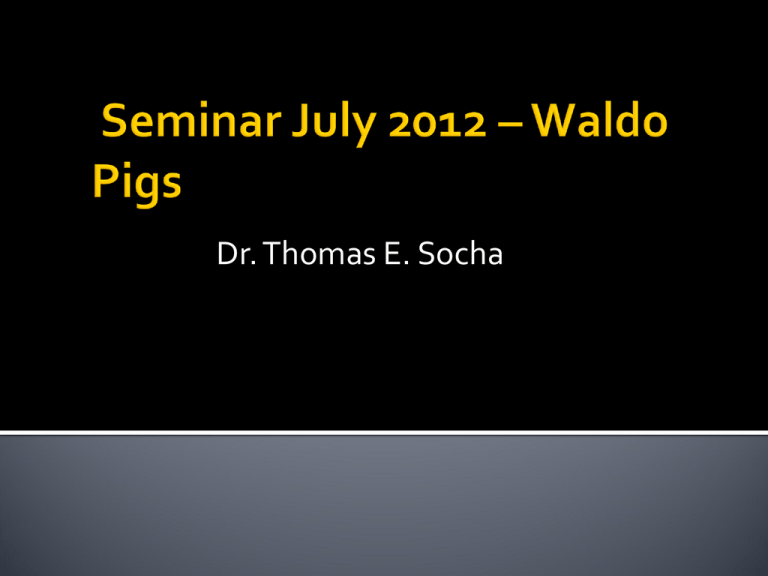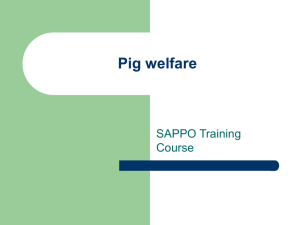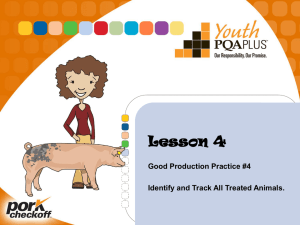
Dr. Thomas E. Socha
Largest Duroc Breeder
Most Litters recorded each Year
More Genetic Diversity than other Duroc Breeders
Continually out perform other Duroc breeders
▪ National Barrow show
▪ Other NPPC tests
Six A.I. Centers use only Waldo Duroc or
Duroc Cross terminal sires
Use pooled semen for commercial producers
Approximately 1,000 boars per year
Large producers use only Waldo boars in their
private A. I. centers
Several National Tests have proven Waldo’s
are the best
Best for Growth Rate
Best for Feed Efficiency
Best at National Barrow Show based on the
performance of their Offspring
Have been Tested against other Durocs, PIC,
Danbred and other companies
Herds Originated from Caesarean derived
pigs
Herd additions are by lab or A.I. only
No live pigs are brought into the Nucleus
herds
Continual Blood Testing and Slaughter
inspections
Growth Rate
Feed Efficiency
Carcass Lean Percentage
Meat Quality
Body Conformation
Continual Selection for Economically
Important Traits
Duroc are fastest growing of all pigs
York and Landrace are the fastest growing of
York and Landrace in the U.S.
Based on data from National Swine Registry
Fewer Days for getting to Market weight
From 30kg to Market – Groups average daily
gains are .8 - .9 kg / day
Reduce the amount of Finisher Space Needed
At .6kg per day you need space for 121 days
At .8kg per day you need space for 91 days
Results from Rapid Lean Growth
Growth Rate and Leanness are related to Efficiency
by 30%
Saving 10% in Feed Usage can result in 90rmb per
pig or 810-900rmb per litter
This is worth more than getting 2 more pigs per
litter
Best way to DECREASE production costs
Presently most pigs are at 3.0 feed conversion
Waldo pigs can be 2.7 – 2.8 conversion
Save .3kg of feed for each kg of pig weight
100 kg pig will save 30 kg of feed
At 3rmb per kg of feed (3 X 30 = 90rmb)
Each litter has 9-10 pigs (810 – 900rmb / litter)
2 extra pigs / litter 350rmb (175rmb / pig)
Improved feed efficiency is more important than increasing
litter size
By the U.S. system Waldo Pigs average 56 –
60 % lean
This is at 130-140 kg
This is considered the ideal lean percentage
for commercial pigs
Pigs that are too lean cause problems in skinning
and in having thin bellies
Started testing 1992
High pH Values
High Intramuscular Fat Percentage
Good Color Scores (Visual & Minolta)
Thick Belly Walls that are Firm
Excellent Meat Flavor
Proper feet and leg structure for longevity
Higher percent of high value cuts
Loin, Ham and Belly
Ability to grow fast and stay lean at heavier
weight which may become more important in
China than what is considered today
Growth rate, Leanness, and litter size
Have proven Continual Genetic improvement over
the last twenty years
Customers can be assured that the Genetics they
get in the future will be improved above the current
Genetics
Changes made in the selection techniques over time
will reflect what is best for the swine industry
Many factors are used to produce the best
pigs
Waldo pigs in China will follow the same
procedures as those used in the U.S.
Many of the procedures have been used for
over 40 years in the U.S.
Data collected on over 95% of all pigs raised
on the farm
Growth rate and backfat -1960
Litter traits added 1980
Loin size added 1992
Need to test as Many pigs as possible to find the
very BEST
Methods must be as easy as possible to help get the
job done
Could be testing 300 pigs per week
At 60 pigs/ hour – 5hours per week
Need to Adjust all Records to a Standard
Backfat at 100kg
Days to 100kg
Loin size at 100kg
Litter weaning weights at 21 or 28 Days
The Most Important item in a Selection program is
MAKING GENETIC improvement
A Consistent program must be followed over time
When Methods of Evaluation, testing procedures
and Indexes are decided, they should not change for
at least 5 years
Re-evaluation of all procedures is required every 510 years
Gilts – Top 25%
Boars
-4
-3
-2
-1
mean
+1
+2
+3
+4
Growth- heritability = .35
Days to market - standard deviation = 10 days
Feed efficiency
Leanness – heritability = .50
Backfat – standard deviation = 2.0 mm
Loin eye size
Reproduction – heritability = .20
Number of pigs born and raised – standard deviation = 2.0 pigs
Days to market
1979-160 days to 100 kg
2009-148 days to 115 kg
About 1 day per year improvement
Backfat
1979-20mm at 100 kg
2009-14mm at 115 kg
About 0.3 mm decrease per year
Requires Labor and Dedication
Litter Birth weights
Number Born Alive
21 Day litter weights
Number at 21 Days
Weight, Backfat, Loin Size at about 140-150
days
Meat Quality Traits
Sow Productivity Index (SPI)
In Herdsman program (sow index)
Litter birth weight
Number born alive
21 day litter weight
Survival at 21 days
Used for evaluating and culling sows
Terminal Breeds – used for sire side
Growth rate 50%
Leanness 30%
Litter traits 20% (SPI values)
Maternal Breeds – Used for female side
Litter Traits 40% (SPI values)
Growth rate 40%
Leanness 20%
Selection
Keeping the best animals
▪ Boars
▪ Gilts
Culling
Sell poorest animals
▪ Performance of Offspring
▪ Reproduction of females
Rank each sex by their breed index after testing most important part of selection
Determine how many of each sex must be selected
Evaluate 200% of needed boars-phenotype
If we need 2, we select the top 4 to evaluate
Evaluate 150% of needed gilts-phenotype
If we need 20, we select the top 30 to evaluate
Length of body
Loin Width
Levelness of the top
Levelness of rump
Width of hams
Too large can affect the ability to move or to decrease longevity in
breeding system
Too small can reduce overall leanness and decrease high quality meat
cuts
Depth of chest
Genetic Change = Selection intensity X
heritability X standard deviation
Change per Year = Genetic Change /
generation interval
Age of parents when replacements are born
Ideally the generation interval should be about
1.50 -1.75 years
We need to make genetic progress, so we need to
turn generations as quickly as possible
Boars should generally be used for 9 – 12 months
Females should generally be used to produce 2 -3
litters
If we keep the same animals around for three years
we make no progress during that time
We expect the next generation to be better than the
last if we are selecting properly
Cull boars based on breeding percentage, offspring
performance and feet and legs
Females should be culled based upon SPI values and
for injury problems
Should cull 20% of each group weaned
Each female will farrow 2.4 times / year
This will mean culling 50% per year
Breeder herd progress
G
e
n
e
t
i
c
C
h
a
n
g
e
Buyer herd
One generation behind
Generations of Breeding
Maternal Effects
Litter size
Milking Ability
York and Landrace
Terminal Effects
Growth Rate
Feed Efficiency
Duroc is the Best
Advantages of crossbred pigs
Heterosis effects – greatest for traits with
lower heritabilities
Two breed gilts
One extra pig born –Y=11.9, L=11.8; then Y X L
= 11.85 + 1 =12.85
Three breed market hogs
100% heterosis = 7 days faster to market
If all replacements come from Nucleus herd
Maternal traits
Must produce
Must raise pigs
Culling 15% in each group
Annual culling about 35-40%
Rations need to have all essential ingredients
Protein
Energy
Vitamins
Minerals
Testing of Pigs
All Pigs have performance data
Tested at 100 kg (120-130 kg)
Growth
Back fat
Loin eye area
Ultra sound equipment
Aloka 500
Mr. Fu, owner of Liuma-Waldo
JV farm at Beijing
Need five or six different rations
Starter feed
N1 (10 – 15 kg)
N2 (15 – 30 kg)
F1 (30 – 70 kg)
F2 (70 – 100 kg)
Feed Full Feed (ad-lib) until 120kg
Limit Feed from 120 kg to breeding
2.5 kg per day
Want gilts to gain 450 grams per day
Increase feed two weeks before breeding
Flushing effect to improve litter size
Limit feed from breeding to 100days
2.5 kg per day
Feed 0 kg on day they farrow
Bring up to full feed
York and Landrace – about 5 days
▪ Increase 1.5 kg per day
Duroc – about 7 days
▪ Increase 1.0 kg per day
Weight loss in Lactation- 18 – 20 kg
Body
Protein
Reproduction
Milk
Farrowing House
Fill in one week
Nursery
Fill in 1 – 2 weeks
Can be from 2 farrowing rooms
Finisher
Fill with 1 – 2 weeks ages
Must circulate and change air
Sow Housing And Finishing
Cool Season – use natural ventilation
Hot Season – use tunnel ventilation with cool cells
Farrowing and Nursery
Use multiple inlets with fan exhaust
Could have cool cell for hot weather





